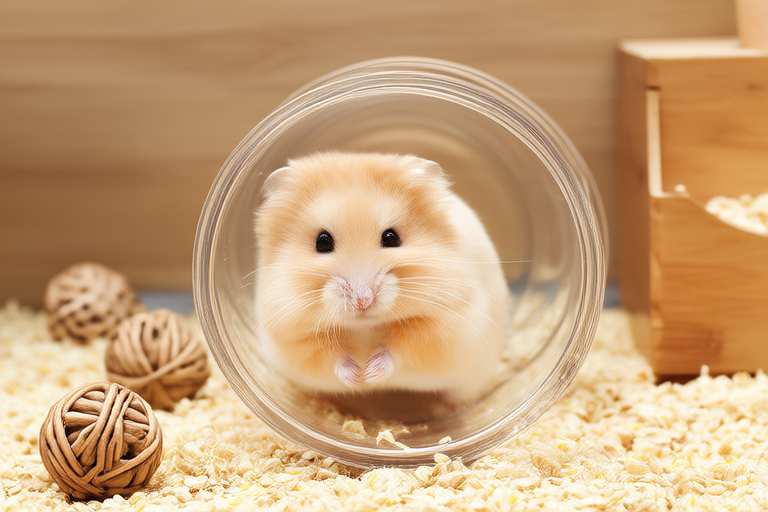The Ultimate Guide to Hamster Toys and Enrichment Activities
Hamsters are small, adorable creatures that require proper care and attention to thrive. Providing your pet with a stimulating and enriching environment is crucial for their physical and mental well-being. This guide will walk you through various toys suitable for hamsters, how to choose them based on breed and size, the importance of mental stimulation and physical exercise, setting up an enriching environment, DIY toy ideas, safety considerations, and common mistakes to avoid.
Understanding Hamster Needs
Hamsters are nocturnal animals, meaning they are most active during the night. They are naturally curious and enjoy exploring their surroundings. A hamster’s habitat should mimic their natural environment as closely as possible, providing opportunities for digging, climbing, and running.
Selecting Appropriate Toys Based on Breed and Size
There are several hamster breeds, each with unique characteristics and requirements. Syrian hamsters, the largest breed, need more space and bigger toys compared to dwarf hamsters like the Roborovski and Campbell’s. Syrian hamsters can also be solitary, so they might not appreciate toys designed for social interaction. Dwarf hamsters, on the other hand, are more sociable and may enjoy interactive toys with other hamsters.
Variety of Hamster Toys
Tunnels
Tunnels are essential for hamsters as they provide a place to hide, explore, and feel safe. They come in various shapes and sizes, such as straight tunnels, zigzag tunnels, and even tunnels with obstacles. Ensure the tunnel diameter is appropriate for your hamster’s size to prevent discomfort or injury.
Wheels
A wheel is a must-have for any hamster owner. It allows your pet to run and exercise, which is crucial for maintaining a healthy weight and preventing boredom. Look for solid-surface wheels to prevent injuries from their paws getting caught in gaps. Wheels with a minimum diameter of 8 inches are recommended for Syrian hamsters, while smaller wheels are suitable for dwarf hamsters.
Houses
Houses provide a cozy retreat for your hamster. They come in various materials, such as plastic, wood, or cardboard. Plastic houses are easy to clean but may not be as appealing as wooden houses. Cardboard houses are great for chewing but need regular replacement due to wear and tear.
Other Interactive Playthings
- Balls: Exercise balls allow hamsters to explore safely outside their cage. Always supervise your hamster during ball play to ensure they don’t get overheated or injured.
- Chew Toys: Chew toys help keep your hamster’s teeth trimmed and prevent dental issues. Wood chews, cardboard rolls, and hay are excellent choices.
- Plastic Toys: Plastic toys, such as bridges and ladders, encourage climbing and exploration. Ensure they are durable and free from harmful chemicals.
- Interactive Toys: Puzzle feeders and treat-dispensing toys stimulate your hamster’s mind and encourage problem-solving skills.
The Importance of Mental Stimulation and Physical Exercise
Mental stimulation and physical exercise are vital for a hamster’s overall health. Without adequate activity, hamsters can become bored, stressed, or develop behavioral issues. Regular exercise helps maintain a healthy weight, improves cardiovascular health, and reduces the risk of obesity-related diseases.
Setting Up an Enriching Environment
To create an enriching environment, start by arranging the cage in a way that encourages exploration and movement. Place toys and accessories at varying heights to promote climbing and jumping. Rotate toys periodically to keep your hamster engaged and prevent boredom.
DIY Toy Ideas
Creating homemade toys is a fun and cost-effective way to provide your hamster with new and exciting playthings. Some ideas include:
- Cardboard Rolls: Cut cardboard toilet paper or paper towel rolls into different lengths and arrange them in the cage for your hamster to chew and explore.
- Paper Bags: Fold paper bags into triangles or squares and place them in the cage for your hamster to shred and play with.
- Yarn Balls: Wrap yarn around a tennis ball or similar object, then remove the core. The yarn ball can be used for playing and chewing.
- Hay Forts: Use hay to build forts or tunnels for your hamster to explore and hide in.
Safety Considerations
When choosing or creating toys for your hamster, always prioritize safety. Avoid toys made from materials that can be ingested or cause choking hazards. Check for sharp edges, loose parts, or toxic substances. Supervise your hamster during playtime to ensure they are using the toys safely.
Common Mistakes to Avoid
Some common mistakes hamster owners make include:
- Providing too few toys, leading to boredom and stress.
- Choosing inappropriate toys for the hamster’s size or breed.
- Overlooking the importance of mental stimulation.
- Not rotating toys regularly, causing the hamster to lose interest.
- Ignoring safety concerns when selecting or creating toys.
Signs Indicating a Need for Different Types of Enrichment Activities
If your hamster exhibits signs of boredom or stress, it may be time to introduce new toys or change their environment. Signs to watch for include:
- Excessive chewing on cage bars or other inappropriate objects.
- Lethargy or lack of interest in food or water.
- Aggression or territorial behavior.
- Overgrooming or self-harm.
Consult with a veterinarian if you notice any concerning behaviors or health issues in your hamster.
Conclusion
Providing your hamster with a variety of toys and enrichment activities is essential for their physical and mental well-being. By understanding your hamster’s needs and preferences, you can create an environment that promotes happiness and health. Remember to rotate toys regularly, prioritize safety, and seek professional advice if needed.
